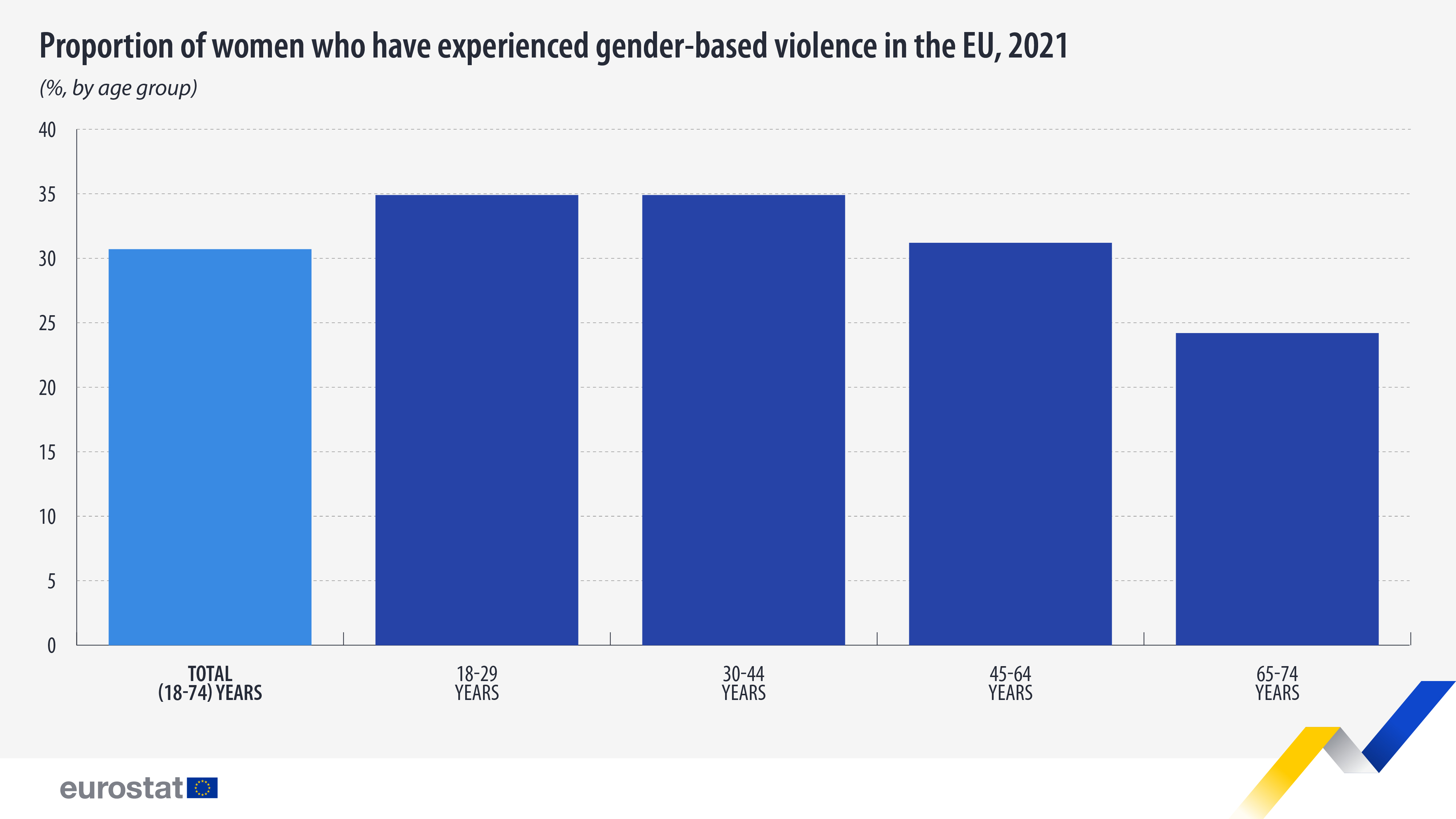Every third woman in the EU experienced gender-based violence

Around 50 million women aged 18-74 in the EU, or 31%, experienced physical (including threats) or sexual violence in adulthood, based on the EU gender-based violence survey (wave 2021).
When comparing the prevalence of gender-based violence by age group, 35% of women in the youngest age group (aged 18 to 29) reported experiencing gender-based violence, compared with 24% in the oldest age group (aged 65-74).
Data also show that home is not always a safe place for many women. In 2021, 18% of women who had ever had a partner experienced physical or sexual violence by their partner, and if psychological violence is also taken into account, 32% have or have had a violent partner in their lifetime.
Source dataset: gbv_any_age
1 in 8 women have experienced sexual violence, including rape, by a non-partner
Based on the EU gender-based violence survey (wave 2021), 20% of women experienced physical (including threats) or sexual violence by a non-partner, with 9% experiencing degrading or humiliating acts other than rape, another 7% pointing to physical and not sexual violence and 4% having experienced rape.
The percentage of women who said that they had experienced non-partner violence was higher in Finland (47%), Sweden (42%), Denmark (38%), the Netherlands (36%) and Luxembourg (34%). In contrast, Bulgaria (6%), Poland (8%) and Czechia (10%) registered the lowest percentages.
The analysis of non-partner violence by type shows that the greatest differences between EU countries concerning non-partner violence are seen in the prevalence of degrading or humiliating sexual acts other than rape. Values ranged between 24% in Finland and 22% in Sweden and below 2% in Bulgaria, Czechia, and Poland.
Source dataset: gbv_npv_type
This article is based on joint data collection by Eurostat, the European Union Agency for Fundamental Rights (FRA) and the European Institute for Gender Equality (EIGE).
This article marks the International Day for the Elimination of Violence Against Women, observed every year on 25 November.
For more information
- Statistics Explained article on gender-based violence
- Podcast on gender-based violence
- Thematic section on gender-based violence
- Database on gender-based violence
- Joint key results publication by Eurostat, FRA, EIGE
- Press release on the joint key results publication
- Statistical report on the first results of the EU survey on gender-based violence against women and other forms of inter-personal violence (EU-GBV)
Methodological notes
- Eurostat coordinated data collection in 18 EU countries (Belgium, Bulgaria, Denmark, Estonia, Greece, Spain, France, Croatia, Latvia, Lithuania, Malta, the Netherlands, Austria, Poland, Portugal, Slovenia, Slovakia, Finland), where the survey was implemented by National Statistical Authorities. Italy shared comparable data for the main indicators based on its national survey. For 8 EU countries (Czechia, Germany, Ireland, Cyprus, Luxembourg, Hungary, Romania, Sweden) the European Union Agency for Fundamental Rights (FRA) and the European Institute for Gender Equality (EIGE) coordinated the data collection, which was carried out by private companies in accordance with the EU-GBV survey guidelines.
- The development of the EU-wide survey on gender-based violence began in 2016. Testing of the questionnaire and methodology was carried out at national level over the period 2017–2019. The main survey implementation started in 2020 and data collections ran from September 2020 – March 2024 (wave 2021).
- It should be noted that the prevalence of gender-based violence as reported in the survey varies at national level. Based on the literature review and as described in the survey guidelines, the extent to which violence is tolerated in the wider community might influence the number of women who are ready to share their experience of violence in the survey. For example, the greatest differences between EU countries concerning non-partner violence are seen in the prevalence of degrading or humiliating sexual acts other than rape. Women who do not consider as acceptable degrading or humiliating sexual acts carried out by a partner or non-partner might be more ready to disclose violent experiences.
- The survey results showed the differences of prevalence rates between age groups. In general, reporting experiences in the survey that may have happened some time ago could be impacted by recall issues. However, a lower prevalence rate for older age groups may also be related to the social norms which existed or still exist in a country, implying that the respondent did not consider relevant sharing this kind of experience even via the survey.
- Methodological issues and quality of the survey is provided in the metadata.
If you have any queries, please visit our contact us page.


